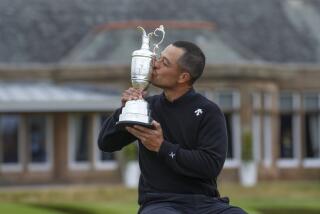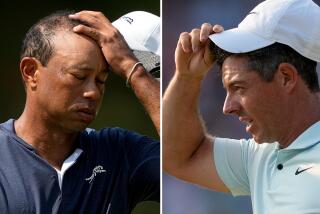Curtis’ Secret Out in Open
- Share via
SANDWICH, England — So when exactly did the Claret Jug turn into the Curtis Cup?
And while we’re at it, who is Ben Curtis?
For the record:
12:00 a.m. July 23, 2003 For The Record
Los Angeles Times Wednesday July 23, 2003 Home Edition Main News Part A Page 2 National Desk 0 inches; 33 words Type of Material: Correction
British Open -- Davis Love III shot a 72 in the fourth round of the British Open. His score was incorrectly reported as 66 in a Sports graphic Monday of the leaders’ scorecards.
On a sunny Sunday afternoon at sprawling Royal St. George’s, the unassuming and unheralded 26-year-old from a tiny town in Ohio introduced himself to the world of golf as the guy who had just won the British Open.
With a final-round, two-under-par 69, Curtis outlasted a quartet of professional golf’s most battle-tested shot makers and managed to bag a big one, scoring his first victory in golf’s oldest major tournament. Curtis’ total of 283 meant he was the only player who finished under par.
The 396th-ranked golfer in the world beat Thomas Bjorn and Vijay Singh by one shot and Tiger Woods and Davis Love III by two.
To say the least, it’s a stunning achievement. It vaults Curtis into the role of the biggest surprise winner of a major since Jack Fleck defeated Ben Hogan in a playoff to win the 1955 U.S. Open.
“I know the names that are on the trophy,” Curtis said. “I’m in great company, and I feel like I don’t belong right now. But I knew in my mind that I did. Right now, there are probably people saying, ‘Well, he doesn’t really belong there,’ but I know I do, so that’s all that matters.”
Fair enough, but maybe more people should have known more about a person before he wins something like the British Open.
For instance, Fred Couples wasn’t sure who Curtis was until Sunday.
“I didn’t know if he was an American or not,” Couples said.
It’s easy to understand the problem. Curtis, from tiny Ostrander, Ohio -- population 405 -- hadn’t played the PGA Tour before this year. And he hadn’t played in a major before.
He hadn’t finished higher than 13th in a regular tour event.
He didn’t even get into the British Open until he tied for 13th at the Western Open three weeks ago.
He was three shots behind with four holes to go.
But he steered a nerve-racking, 8-foot putt straight into the bottom of the hole to save par at the 18th hole, then waited on the driving range while Bjorn lost his grip on a trophy that seemed to be his.
Instead, Curtis had his name engraved on the Claret Jug, the British Open trophy, and as it was presented to him, he was announced to the cheering gallery at the 18th in the traditional way: “Ladies and gentlemen, the champion golfer of the year.”
Not bad for a guy who began the week ranked 396th in the world.
That champion label might have been Bjorn’s if not for what happened at the 163-yard, par-three 16th, in one of Royal St. George’s 106 bunkers.
Bjorn’s tee shot wound up at the bottom of a bunker at the right of the green, but Bjorn needed three shots to get out. Not once, but twice did the ball pop over the lip of the bunker and then dribble back into the sand at his feet.
“It was probably just poor bunker shots at the wrong time,” Bjorn said.
If Bjorn wasn’t kicking himself, there were plenty of others who could have been taking part in the exercise themselves.
Love began the day one shot behind Bjorn and promptly bogeyed three of the first four holes. In keeping with the theme of the day, all Love’s drama came on the backside.
By the time he reached the 15th green, Love was back to even par for the tournament, but he missed a birdie putt at the 16th that would have tied him with Curtis, who was done, and Bjorn. Love took himself out of it with a bogey at the 17th and shot a one-over 72 to tie Woods for fourth place.
“I got myself so far behind I didn’t have a chance,” Love said. “Things came crashing back to us like it always seems to and I just didn’t have quite enough. If I had putted well, I would’ve won. Thomas, Tiger and Vijay are all saying the same thing.”
Singh had a chance too, but he bogeyed the 16th that caused Bjorn so much misery and couldn’t birdie any of the last three holes to pick up a shot that would have forced a playoff.
“I had my chances and I blew it,” Singh said. “There’s no excuse for that.”
Woods was one under through 14 holes, but he bogeyed the 15th when he missed the green. He was still only one shot out of the lead when he missed the green at the 17th and left it short. He chipped up but missed a 15-footer for par.
“I fought all day,” he said. “I had it going early, but I just didn’t make any putts on the back nine.”
No one’s misery could equal Bjorn’s. Although a three-shot lead with four to play sounds like a lot, remember that Jean Van de Velde had a three-shot lead with a hole to play in 1999 at Carnoustie and blew it, losing in a playoff that Paul Lawrie won.
Bunkers were not very kind to Bjorn. He took a two-shot penalty Thursday when he grounded his club in a bunker. Still, Bjorn overcame that error and had become about as consistent as you can get.
In a 44-hole stretch, he had only two bogeys. But then came a bogey avalanche. He bogeyed the 15th when he drove into a fairway bunker, doubled the 16th and bogeyed the 17th.
The difference between Curtis’ winning share of $1,112,720 and Bjorn’s runner-up share of $548,412 is $564,308. That would buy a lot of sand.
“It was an expensive mistake,” Bjorn said of his errant tee shot at the 16th. “I tried to hit every single shot in the middle of the green all day and I just got one there that got caught up in the wind a little bit and it leaked off to the right.
“That’s the way the Open golf is. And that’s the way things happen on the golf course. I had my good breaks this week, but I got a bad one there and lost the Open on that 16th hole.”
Curtis was two shots behind Bjorn to start the day but quickly moved into the lead when he played the first 11 holes in six under par. After that, he said, he started to play too conservatively, but he had just enough to hang on.
He practiced at Royal St. George’s on parts of four days but took Monday off to travel to London to sightsee with his fiancee, Candace Beatty. He said his favorite sight was Big Ben.
“I look up to Big Ben,” he said.
Curtis seemed as stunned as anyone about what had just happened.
“I’m just a normal guy with a lot of talent, and that’s the way I look at it,” he said. “My life is going to change from today, but I’m looking forward to it and a lot of the great challenges ahead of me.”
He earned his PGA Tour card last year in his third trip to qualifying school, after two years on the Hooters Tour. Curtis was an accomplished amateur and won two national junior events in high school, where he was a shooting guard on the basketball team at Buckeye Valley High in Delaware, Ohio.
He picked up a golf club for the first time when he was 3 and started hanging around the practice putting green of Mill Creek Golf Club, which his grandfather had built and where his father was superintendent.
A three-time All-American at Kent State, Curtis won consecutive Ohio state amateur titles. The only others who won back-to-back state amateurs are Arnold Palmer and John Cook. After his second state title, Curtis received a letter from Palmer. Curtis thought it might have been a joke until he saw that Palmer had indeed sent the note. Palmer had written this: “Welcome to the club.”
They’re saying the same thing right now at Royal St. George’s.
*
(BEGIN TEXT OF INFOBOX)
*--* Major Collapses A look at players whose games have failed them at the most inopportune times in major championships: NAME TOURNAMENT QUICK COMMENT SAM SNEAD 1939 U.S. Open Gets an eight on the final hole to finish two strokes out of a playoff. He never wins an Open BEN HOGAN 1946 Masters Three-putt bogey on the 18th hole leaves him a shot behind winner Herman Keiser BEN HOGAN 1946 U.S. Open Another three-putt bogey on 18 keeps him out of a playoff ARNOLD PALMER 1961 Masters Loses to Gary Player after a double bogey on 18 ARNOLD PALMER 1966 U.S. Open Leading by seven with nine holes to play, he ends up in a playoff and loses to Billy Casper DOUG SANDERS 1970 British Open Three-putts on 18, missing 2-footer for par, to fall into playoff with Jack Nicklaus, which he loses GREG NORMAN 1993 PGA Three-putts from 15 feet in sudden-death playoff, giving Paul Azinger the victory GREG NORMAN 1996 Masters Blows a six-stroke lead Sunday and shoots 78 to lose to Nick Faldo by five JEAN VAN DE VELDE 1999 British Open Needing only a double bogey on 18 to win, he ends up with a triple bogey and loses in a four-way playoff STEWART CINK 2001 U.S. Open Three-putts from 15 feet, missing from 18 inches, to fail to get into playoff THOMAS BJORN 2003 British Open After going four-over par on Nos. 15-17, loses to Ben Curtis by one shot
*--*
*
*--* Major Surprises A look at some of the longest longshots to win major championships: PLAYER TOURNAMENT QUICK FACT FRANCIS OUIMET 1913 U.S. Open 20-year-old amateur in his first major, defeated Harry Vardon in a playoff TOM CREAVY 1931 PGA Obscure club pro defeated Gene Sarazen and Denny Shute in match play SAM PARKS JR 1935 U.S. Open Another no-name who outlasted such players as Sarazen and Walter Hagen TONY MANERO 1936 U.S. Open A second consecutive shocking winner in this major CLAUDE HARMON 1948 Masters Club pro and father of teacher Butch Harmon won for his only victory on PGA Tour JACK FLECK 1955 U.S. Open Defeated Ben Hogan in playoff for his first tour victory ORVILLE MOODY 1969 U.S. Open His only PGA Tour event before becoming a force on the senior tour JOHN DALY 1991 PGA Ninth alternate won for the first time on tour at Crooked Stick in Indiana
*--*
*
TOP FINISHERS
*--* 283 (-1)--$1,112,720 Ben Curtis...72-72-70-69 284 (E)--$548,412 Vijay Singh...75-70-69-70 Thomas Bjorn...73-70-69-72 285 (+1)--$294,076 Tiger Woods...73-72-69-71 Davis Love III...69-72-72-72 286 (+2)--$213,801 Brian Davis...77-73-68-68 Fredrik Jacobson...70-76-70-70 287 (+3)--$155,383 Nick Faldo...76-74-67-70 Kenny Perry...74-70-70-73 Complete scores...D9
*--*
More to Read
Go beyond the scoreboard
Get the latest on L.A.'s teams in the daily Sports Report newsletter.
You may occasionally receive promotional content from the Los Angeles Times.










